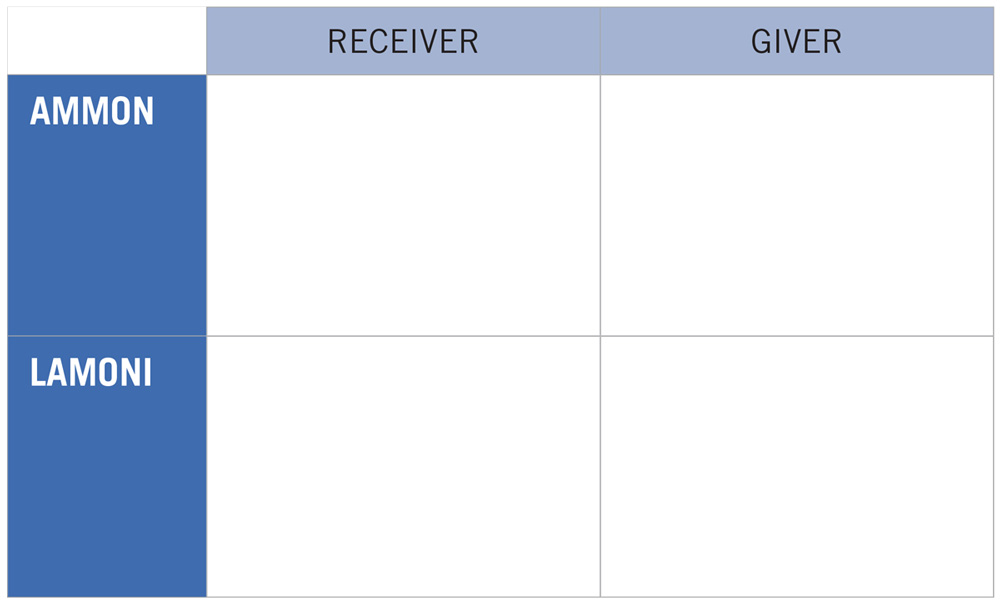Before coming to your training, please do the following:
“Without self-reliance one cannot exercise these innate desires to serve. How can we give if there is nothing there? Food for the hungry cannot come from empty shelves. Money to assist the needy cannot come from an empty purse. Support and understanding cannot come from the emotionally starved. Teaching cannot come from the unlearned. And most important of all, spiritual guidance cannot come from the spiritually weak” (Marion G. Romney, “The Celestial Nature of Self-Reliance,” Ensign, Nov. 1982, 93).
“The Lord blesses those who want to improve, who accept the need for commandments and try to keep them. . . . He will help you repent, repair, fix whatever you have to fix, and keep going. Soon enough you will have the success you seek” (Jeffrey R. Holland, “Tomorrow the Lord Will Do Wonders among You,” Ensign or Liahona, May 2016, 126).
In this lesson, you will discuss the importance of becoming converted to the doctrine of work and service at Deseret Employment, as well as three tools to promote that change: setting high standards, establishing a safe training environment, and becoming givers and receivers. As you understand the doctrine and process of conversion and learn to use the correct principles, you will be enabled to assist associates as they pursue their conversion to work and service. Through this conversion, both you and your associates will experience joy in one another’s successes.
From the following list, choose and complete one or more activities that best apply to your situation.
Use the internet to find the definition and root of the word conversion (see Merriam-Webster’s online dictionary, at m-w.com). As a group, share and discuss three or four things you learned from this exercise.
Then consider what you learned and read in preparation for this class as you discuss as a group the following questions:
Conversion is a process rather than an event. In this process people convert to different principles and doctrines at different times. At Deseret Employment, you should strive to help associates become converted to the doctrine of work and service.
As a group, discuss the following:
As a group, list on the board indicators or elements of conversion from your assigned readings. Then discuss whether there are any additional elements to add.
At Deseret Employment, you should strive to help associates become converted to the doctrine of work and service. Conversion to the doctrine of work and service is similar to conversion to Christ.
As a group, discuss the following:
From the following list, choose and complete one or more activities that best apply to your situation.
Look at the AWARE form. Then, as a group, discuss the following:
As a group, watch two different AWARE (Coaching) videos. Immediately after watching each video, discuss the following questions:
Associates differ from each other in their preparation, communication abilities, skills, interests, and so forth. At times, we might work with an associate who has a disability due to violence, an accident, genetics, or other reason.
As a group, discuss the following:
Take a few minutes to ponder the following questions individually:
After pondering privately, take a few minutes to share any questions or concerns with the rest of the group.
From the following list, choose and complete one or more activities that best apply to your situation.
As a group, discuss what constitutes a safe training environment.
Take a minute individually to think about one of the worst mistakes you’ve made. Put yourself back in the time when the mistake occurred.
Consider the following questions:
Read Matthew 19:16–22, or watch “Christ and the Rich Young Ruler” from The Life of Jesus Christ Bible Videos.
Divide into small groups. With your group, consider the rich young ruler as if you were his job coach trainer. At the end of this story, he went away sorrowful and unwilling to act on the invitation the Lord had extended. Now your job is to help this young man get to a place where he is willing to follow the Savior’s invitation. Create a development plan that could help the young man change. In your learner’s journal, write out your plan’s details and any significant observations.
Following the exercise, compare and contrast your plan with the plans developed by other groups.
From the following list, choose and complete one or more activities that best apply to your situation.
Write a story using one of your current associates as the main character. Include one or two of the work behaviors that he or she is struggling to adopt. Write the happy ending for your associate that you want him or her to experience as a result of training.
Consider the following questions (you could display them on the board for class members):
Watch the video Johnny Barbata’s Story, about a Deseret Industries associate. Write a list in your learner’s journal of every emotion you see or hear about during the change process for Johnny, along with who experienced the emotion.
Johnny Barbata's Story
Following the video, compare lists as a group and fill in any emotions that you may have missed. Then answer the following questions as a group:
Review King Lamoni’s conversion story (see Alma 17–19) and the role Ammon played in helping him become converted. Identify instances and ways that:
Divide into four groups. With your group, fill out the receiver and giver columns of the following table as you watch the video “Chapter 23: Ammon: A Great Servant” (on LDS Media Library) and read Alma 19:14.

As a group, discuss the following questions:
Seek to identify a personal or business gap or need.
Spend a few minutes silently pondering what you've discussed during this lesson. Listen as the Holy Ghost helps you identify areas where you can improve. Record your impressions in your learner's journal under the question “What Lack I Yet?”
Seek ways to close the gap or develop the required talent(s) to meet the need.
With the guidance of the Spirit, create your plan of how you will improve and close the gap(s) you have identified. You may use one or more of the exercises below, your own strategy, or a combination of both. Record this plan in your learner's journal under “What Must I Do?”
After a few minutes, those who are comfortable doing so can share their impressions with the group.
Seek understanding, and then share what you learned.
During the week, focus on implementing the plan you created. Record your impressions or lessons learned in your learner's journal under “Therefore, What?” You will be given time at the beginning of next week's lesson to share your experience with the group.

Use these additional materials if you would like to learn more about how to inspire conversion to the doctrine of work and service.
